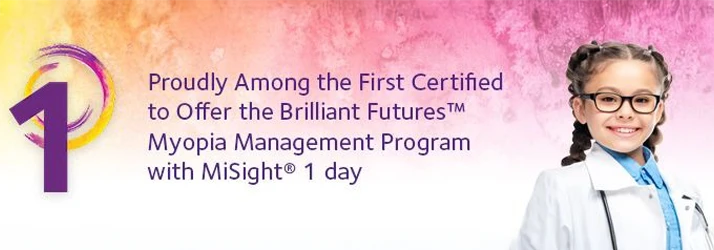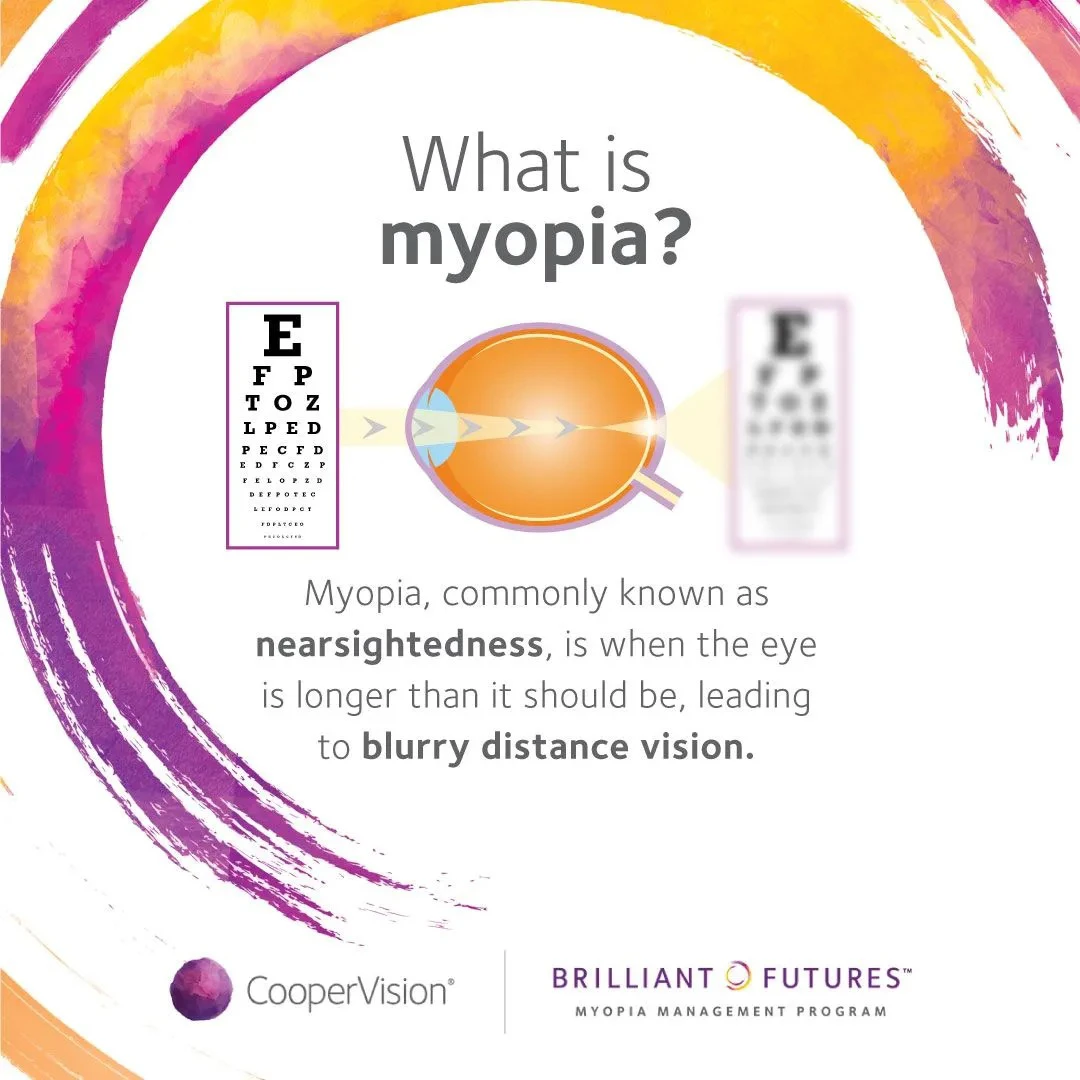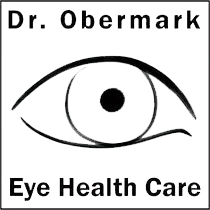Nearsightedness: Myopia Management

If you suffer from myopia in Poplar Bluff MO or Sikeston MO, there is no better management solution for you than the one we offer at Dr. Obermark Eye Health Care. We are proudly among the first certified providers in CooperVision's Brilliant Futures Myopia Management Program.
Myopia, also known as nearsightedness, is the inability to see objects clearly at a distance. The eyeball elongates, causing light rays to focus incorrectly in the eye, thus making distance vision blurry.
What Causes Myopia?
 Myopia is becoming an increasingly common condition, especially in school-aged children. Myopia occurs during childhood with many factors contributing to the continuously progressing condition, including genetics. Children have a one in four chance of developing myopia even if neither parent has been diagnosed with the condition, but a child whose parent(s) have myopia, increases the child's chances of developing nearsightedness by double. Also, their environment can play a major role, with research showing that children who spend more time outside are less likely to develop myopia.
Myopia is becoming an increasingly common condition, especially in school-aged children. Myopia occurs during childhood with many factors contributing to the continuously progressing condition, including genetics. Children have a one in four chance of developing myopia even if neither parent has been diagnosed with the condition, but a child whose parent(s) have myopia, increases the child's chances of developing nearsightedness by double. Also, their environment can play a major role, with research showing that children who spend more time outside are less likely to develop myopia.
As the eye continues to grow and the number of myopia increases, ocular tissues change in response to the eye growth, resulting in eye health risks that are not as evident in a non-myopic eye. The more nearsighted a child is, the greater the risks become. Leaving it untreated could result in cataracts, glaucoma, retinal detachment, and myopia maculopathy.
How Dr. Obermark Eye Health Care Can Help Myopia
We now have a way to manage myopia, and the earlier managing myopia starts, the better the outcome. MiSight 1 Day, the only contact lens approved by the FDA for managing myopia, slows progression. By slowing the progression of myopia, we can reduce the risks that are likely to come later in life.
Managing myopia starts here at Dr. Obermark Eye Health Care, the only practice certified to help children with myopia within a 50-mile radius. Learn more today by calling for your child's next appointment.
Success in school starts with clear vision. Click here to launch a myopia simulator and see how your child sees with myopic vision.
How Nearsightedness Is Diagnosed
A comprehensive eye exam is the most effective way to diagnose myopia. At Dr. Obermark Eye Health Care, we use advanced diagnostic tools and proven testing methods to accurately assess vision and determine the right prescription.
What to Expect During a Myopia Evaluation:
Health and Vision History
Your optometrist will review your general health, family history of eye problems, and any current vision concerns. They’ll ask about symptoms such as blurry distance vision or frequent headaches.Visual Acuity Test
Using a Snellen chart, you'll be asked to read a series of letters from a set distance. Each eye is tested individually to assess how clearly you can see.Refraction Testing
A phoropter is used to determine the ideal lens prescription. You'll compare various lens options to identify which provides the clearest vision.Retinoscopy
This technique involves shining a light into the eyes to observe how it reflects off the retina. It is especially helpful when examining young children or patients who struggle to articulate their symptoms.Autorefractor Measurements
Autorefractors and aberrometers provide automated readings of how light bends as it enters the eye, offering a baseline that can be refined during the exam.Eye Health Examination
Using a slit lamp and other diagnostic equipment, your provider will examine the internal and external structures of your eye to rule out any underlying conditions.Dilated Eye Exam
Dilating drops are used to widen the pupils, giving your doctor a better view of the retina, optic nerve, and overall eye health.Additional Testing
In some cases, tests such as keratometry or corneal topography are used to measure the curvature of the cornea and ensure proper contact lens fitting.
Recognizing Myopia in Children
Children may not always verbalize vision issues, but certain behaviors can indicate they are struggling to see clearly. Parents and teachers should be alert for signs such as:
- Squinting to see distant objects
- Holding screens or books very close to the face
- Frequently rubbing their eyes
- Complaining of headaches or eye fatigue
- Sitting close to the TV or front of the classroom
- Seeming unaware of distant people or objects
If your child exhibits these symptoms, it’s important to schedule an eye exam with a qualified optometrist for early diagnosis and intervention.
Why Managing Myopia Progression Matters
Left unaddressed, myopia can worsen over time—sometimes progressing by half a diopter or more each year. Severe myopia (also called high myopia) increases the risk of serious eye conditions such as:
- Retinal detachment
- Glaucoma
- Cataracts
- Macular degeneration
For this reason, slowing the progression of myopia is just as important as correcting current vision problems. Early management helps reduce long-term complications and the need for stronger prescriptions later in life.
Myopia Control Options: Slowing the Progression of Nearsightedness
We offer evidence-based treatments that not only correct vision but also help control the progression of myopia—especially in children and teens.
- Multifocal Contact Lenses
These specially designed lenses contain different optical zones for distance and near vision. By managing how light is focused across the retina, multifocal lenses help reduce the eye's tendency to elongate. They are effective, comfortable, and ideal for active children who want an alternative to glasses. - Orthokeratology (Ortho-K)
Ortho-K involves wearing custom rigid contact lenses overnight. These lenses gently reshape the cornea while you sleep, providing clear daytime vision without the need for glasses or contacts. Ortho-K has been shown to significantly reduce myopia progression in many patients. - Multifocal Eyeglasses
Similar to multifocal contacts, these glasses contain multiple prescriptions in a single lens. They reduce strain on the eye when focusing up close, which may help slow axial elongation in growing eyes. They are a convenient option for young patients who may not yet be ready for contact lenses. - Peripheral Defocus Lenses
These lenses alter the way light reaches the peripheral retina, addressing a factor believed to drive eye growth. By changing the peripheral focus, these lenses help guide the eye's growth in a healthier direction and reduce the advancement of myopia. - Low-Dose Atropine Eye Drops
Used nightly, low-concentration atropine drops have been clinically proven to slow the progression of myopia. While they don’t correct vision directly, they are often used alongside other treatments such as glasses or Ortho-K lenses. - Combination Therapy
In some cases, combining treatments provides the best results. For example, a child may wear multifocal contact lenses during the day and use atropine drops at night. This multi-pronged approach addresses several contributing factors simultaneously.
Take Control of Your Vision with Personalized Myopia Management
Managing nearsightedness today can protect your long-term vision health and reduce the risk of serious complications in the future. Whether you or your child is just beginning to show signs of myopia or has been wearing corrective lenses for years, it’s never too early—or too late—to explore your options.
At Dr. Obermark Eye Health Care, we provide customized myopia control plans based on your vision, lifestyle, and goals. From advanced diagnostics to ongoing care, our team is committed to helping patients achieve and maintain clearer, healthier vision for life.
Contact us today to schedule a comprehensive myopia evaluation in Poplar Bluff MO and Sikeston MO. Let us help you see clearly—now and for years to come.



